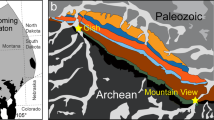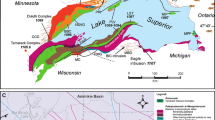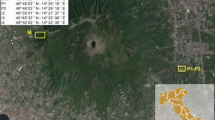Abstract
Olivine from the olivine gabbro to troctolite intrusions at Voisey’s Bay and at Pants Lake, Labrador, was analyzed for multiple elements (Ca, Sc, Mg, Si, Ti, V, Cr, Mn, Fe, Co, Ni, Cu, Zn, Sr, Y, and Zr) with secondary ion mass spectrometry (SIMS). Both intrusions have similar lithologies and petrographic characteristics and are approximately coeval (1.34 and 1.32 Ga, respectively) members of the Mesoproterozoic Nain Plutonic Suite. The Voisey’s Bay intrusion hosts a producing economic Ni-Cu sulfide deposit, whereas the Pants Lake intrusion displays evidence of Ni-Cu sulfide mineralization, but, to date, a viable ore deposit has not been discovered. Olivine from both barren and mineralized lithologies was analyzed to assess the potential of the olivine composition for providing a record of silicate melt evolution and sulfide saturation related to formation of a massive sulfide deposit. Two detailed transects were sampled, using five diamond drill holes that laterally approach the basal massive sulfide in the Eastern Deeps portion of the Voisey’s Bay intrusion from the barren central part. Olivine displays distinct trace element distributions that vary coherently with host lithology and proximity to sulfide mineralization. In particular, olivine shows an increase in Fe (∼Fo80 to ∼Fo60), Mn (∼2500 to 5000 ppm), and Zn (∼280 to 700 ppm), generally coupled with a decrease in Ni (∼1600 to ∼900 ppm), Co (∼270 to ∼190 ppm), and Cr (∼110 to 45 ppm), from barren troctolite (normal troctolite—NT) and weakly mineralized troctolite (variable-textured troctolite—VTT) towards the heavily mineralized, brecciated basal succession (basal breccia sequence—BBS). The enrichment in Fe-Mn-Zn is most pronounced in samples that laterally approach, but do not directly intersect, the massive sulfide deposit at the base of the intrusion, particularly in samples from the lower variable-textured troctolite and the basal breccia. Olivine from gabbro lithologies within the basal gabbro (BG) and upper gabbro (UG) of the Pants Lake intrusion is fairly homogeneous (∼Fo60, ∼4300 ppm Mn, ∼460 ppm Zn, ∼340 ppm Ni, ∼50 ppm Cr), with a more evolved composition (∼2100 ppm Ca, ∼20 ppm Sc, ∼300 ppm Ti, ∼4 ppm Y) than the average olivine of the Voisey’s Bay intrusion (∼570 ppm Ca, ∼6 ppm Sc, ∼65 ppm Ti, ∼0.3 ppm Y). Pants Lake olivine also commonly lacks the mutually Mn-Zn-rich signature of olivine from the basal breccia at Voisey’s Bay that is characteristic of contamination of the parent magma by country rock gneiss, and there reflects a close proximity to massive sulfides. In conjunction with petrographic observation and the stratigraphic context, a multiple-element (V-Cr-Mn-Fe-Co-Ni-Zn) regression can be applied to calculate a lateral proximity of olivine to massive sulfide mineralization in the Eastern Deeps part of the Voisey’s Bay intrusion, over a distance exceeding 150 m. The compositional variations in olivine from the economic Voisey’s Bay intrusion (bimodal and primitive) and the mainly barren Pants Lake intrusion (homogeneous and evolved) provide potential as a regional-scale mineralogical fertility indicator for mafic intrusions with comparable types of sulfide mineralization.










Similar content being viewed by others
References
Amelin Y, Li C, Naldrett AJ (1999) Geochronology of the Voisey’s Bay intrusion, Labrador, Canada, by precise U-Pb dating of coexisting baddeleyite, zircon, and apatite. Lithos 47:33–52
Amelin Y, Li C, Valeyev O, Naldrett AJ (2000) Nd-Pb-Sr isotope systematics of crustal assimilation in the Voisey’s Bay and Mushuau intrusions, Labrador, Canada. Econ Geol 95:815–830
Arndt NT, Lesher CM, Czamanske GK (2005) Mantle-derived magmas and magmatic Ni-Cu-(PGE) deposits. Econ Geol 100th Anniversary vol:5–23
Baker DR, Moretti R (2011) Modeling the solubility of sulfur in magmas: a 50-year old geochemical challenge. Rev Mineral 73:167–213
Barnes SJ, Fiorentini ML (2012) Komatiite magmas and sulfide nickel deposits: a comparison of variably endowed Archean terranes. Econ Geol 107:755–780
Barnes SJ, Godel B, Gürer D, Brenan JM, Robertson J, Paterson D (2013) Sulfide-olivine Fe-Ni exchange and the origin of anomalously Ni rich magmatic sulfides. Econ Geol 108:1971–1982
Beattie P (1994) Systematics and energetics of trace-element partitioning between olivine and silicate melts: implications for the nature of mineral/melt partitioning. Chem Geol 117:57–71
Bindeman IN, Davis AM, Drake MJ (1998) Ion microprobe study of plagioclase-basalt partition experiments at natural concentration levels of trace elements. Geochim Cosmochim Acta 62:1175–1193
Bougault H, Hekinian R (1974) Rift valley in the Atlantic ocean near 36 degrees 50′N; petrology and geochemistry of basalt rocks. Earth Planet Sci Lett 24:249–261
Brenan JM (2003) Effects of fO2, fS2, temperature, and melt composition on Fe-Ni exchange between olivine and sulfide liquid: implications for natural olivine–sulfide assemblages. Geochim Cosmochim Acta 67:2663–2681
Brenan JM, Caciagli NC (2000) Fe-Ni exchange between olivine and sulfide liquid: implications for oxygen barometry in sulfide-saturated magmas. Geochim Cosmochim Acta 64:307–320
Brenan JM, Li C (2000) Constraints on oxygen fugacity during sulfide segregation in the Voisey’s Bay intrusion, Labrador, Canada. Econ Geol 95:901–915
Bulle F (2014) Multi-trace element distribution in olivine from the Eastern Deeps deposit, Voisey’s Bay intrusion, Labrador: olivine composition as a record of ore-forming processes in evolved magma systems. Dissertation, Memorial University. Canada
Bulle F, Layne GD (2014) Secondary ion mass spectrometry for the quantification of multiple minor and trace elements in forsterite–fayalite. Int J Mass Spectrom 361:41–53
Bulle F, Layne GD (2015) Trace element variations in olivine from the Eastern Deeps intrusion at Voisey’s Bay, Labrador, as a monitor of assimilation and sulfide saturation processes. Econ Geol 110:713–731
Campbell IH, Naldrett AJ (1979) The influence of silicate:sulfide ratios on the geochemistry of magmatic sulfides. Econ Geol 74:1503–1505
Canil D, Fedortchouk Y (2001) Olivine-liquid partitioning of vanadium and other trace elements, with application to modern and ancient picrites. Can Mineral 39:319–330
Chalokwu CI, Grant NK (1987) Reequilibration of olivine with trapped liquid in the Duluth complex, Minnesota. Geology 15:71–74
Clark T, Naldrett AJ (1972) The distribution of Fe and Ni between synthetic olivine and sulfide at 900 °C. Econ Geol 67:939–952
Colson RO, McKay GA, Taylor LA (1988) Temperature and composition dependencies of trace element partitioning: olivine/melt and low-Ca pyroxene/melt. Geochim Cosmochim Acta 52:539–553
Condie KC (1993) Chemical composition and evolution of the upper continental crust: Contrasting results from surface samples and shales. Chem Geol 104:1–37
Costa F, Dungan M (2005) Short time scales of magmatic assimilation from diffusion modeling of multiple elements in olivine. Geology 33:837–840
Dare SAS, Barnes SJ, Beaudoin G (2012) Variation in trace element content of magnetite crystallized from a fractionating sulfide liquid, Sudbury, Canada: implications for provenance discrimination. Geochim Cosmochim Acta 88:27–50
De Hoog JCM, Gall L, Cornell DH (2010) Trace-element geochemistry of mantle olivine and application to mantle petrogenesis and geothermobarometry. Chem Geol 270:196–215
Duke JM (1976) Distribution of the period four transition elements among olivine, calcic clinopyroxene and mafic silicate liquid; experimental results. J Petrol 17:499–521
Emslie RF, Hamilton MA, Thériault RJ (1994) Petrogenesis of a mid-Proterozoic anorthosite-mangerite-charnockite-granite (AMCG) complex: isotopic and chemical evidence from the Nain Plutonic Suite. J Geol 102:539–558
Evans-Lamswood DM, Butt DP, Jackson RS et al (2000) Physical controls associated with the distribution of sulfides in the Voisey’s Bay Ni-Cu-Co deposit, Labrador. Econ Geol 95:749–769
Ewart A, Griffin WL (1994) Application of proton-microprobe data to trace-element partitioning in volcanic rocks. Chem Geol 17:251–284
Fiorentini ML, Bekker A, Rouxel O, Wing B, Maier W, Rumble D (2012) Multiple sulfur and iron isotope composition of magmatic Ni-Cu-PGE sulfide deposits from Eastern Botswana. Econ Geol 107:105–116
Fleet ME, MacRae ND, Osborne MD (1981) The partition of Ni between olivine, magma and immiscible sulfide liquid. Chem Geol 32:119–127
Fleet ME, MacRae ND (1983) Partition of Ni between olivine and sulfide and its application to Ni-Cu sulfide deposits. Contrib Mineral Petrol 83:75–83
Gaetani GA, Grove TL (1997) Partitioning of moderately siderophile elements among olivine, silicate melt, and sulfide melt: constraints on core formation in the Earth and Mars. Geochim Cosmochim Acta 61:1829–1846
Hammer Ø, Harper DAT, Ryan PD (2001) PAST: paleontological statistics software package for education and data analysis. Palaeontol Electron 4(1):1–9
Hart SR, Davis KE (1978) Nickel partitioning between olivine and silicate melt. Earth Planet Sci Lett 40:203–290
Jang YD, Naslund HR, McBirney AR (2001) The differentiation trend of the Skaergaard intrusion and the timing of magnetite crystallization: iron enrichment revisited. Earth Planet Sci Lett 189:189–196
Jones RH, Layne GD (1997) Minor and trace element partitioning between pyroxene and melt in rapidly cooled chondrules. Am Mineral 82:534–545
Keays RR, Lightfoot PC (2010) Crustal sulfur is required to form magmatic Ni-Cu sulfide deposits: evidence from chalcophile element signatures of Siberian and Deccan Trap basalts. Mineral Deposita 45:241–257
Kerr A (1999) Mafic rocks of the Pants Lake intrusion and related Ni-Cu-Co mineralization in North–Central Labrador. Newfoundland Dept Mines Energy, Geol Survey Branch Report 99–1:215–253
Kerr A (2003) Nickeliferous gabbroic intrusions of the pants lake areas, Labrador, Canada: implications for the development of magmatic sulfides in mafic systems. Am J Sci 303:221–258
Klemme S, Gunther D, Hametner K, Prowatke S, Zack T (2006) The partitioning of trace elements between ilmenite, ulvospinel, armalcolite and silicate melts with implications for the early differentiation of the moon. Chem Geol 234:251–263
Kloeck W, Palme H (1988) Partitioning of siderophile and chalcophile elements between sulfide, olivine, and glass in a naturally reduced basalt from Disko Island, Greenland. Proc Lunar Plan Sci Conf 18:471–483
Kohn SC, Schofield PF (1994) The importance of melt composition in controlling trace-element behaviour: an experimental study of Mn and Zn partitioning between forsterite and silicate melts. Chem Geol 117:73–87
Lambert DD, Frick LR, Foster JG, Li C, Naldrett AJ (2000) Re-Os isotope systematics of the Voisey’s Bay Ni-Cu-Co magmatic sulfide system, Labrador, Canada: II. Implications for parental magma chemistry, ore genesis, and metal redistribution. Econ Geol 95:867–888
Li C, Lightfoot PC, Amelin Y, Naldrett AJ (2000) Contrasting petrological and geochemical relationships in the Voisey’s Bay and Mushuau intrusions, Labrador, Canada: implications for ore genesis. Econ Geol 95:771–799
Li C, Naldrett AJ (1999) Geology and petrology of the Voisey’s Bay intrusion: reaction of olivine with sulphide and silicate liquids. Lithos 47:1–31
Li C, Naldrett AJ (2000) Melting reactions of gneissic inclusions with enclosing magma at Voisey’s Bay, Labrador, Canada: implications with respect to ore genesis. Econ Geol 95:801–814
Li C, Naldrett AJ, Ripley EM (2001) Critical factors for the formation of a nickel-copper deposit in an evolved magma system: lessons from a comparison of the Pants Lake and Voisey’s Bay sulfide occurrences in Labrador, Canada. Miner Deposita 36:85–92
Li C, Naldrett AJ, Ripley EM (2007) Controls on the Fo and Ni contents of olivine in sulfide-bearing mafic/ultramafic intrusions: principles, modeling, and examples from Voisey’s Bay. Earth Sci Front 14:177–185
Li C, Ripley EM, Maier WD, Gromwe TES (2002) Olivine and sulfur isotope compositions of the Uitkomst Ni-Cu sulfide ore-bearing complex, South Africa: evidence for sulfur contamination and multiple magma emplacements. Chem Geol 188:149–159
Li C, Ripley EM, Mathez EA (2003a) The effect of S on the partitioning of Ni between olivine and silicate melt in MORB. Chem Geol 201:295–306
Li C, Ripley EM, Naldrett AJ (2003b) Compositional variations of olivine and sulfur isotopes in the Noril’sk and Talnakh intrusions, Siberia: implications for ore-forming processes in dynamic magma conduits. Econ Geol 98:69–86
Lightfoot PC, Keays RR, Evans-Lamswood DM, Wheeler R (2012) S saturation history of Nain Plutonic Suite mafic intrusions: origin of the Voisey’s Bay Ni–Cu–Co sulfide deposit, Labrador, Canada. Miner Deposita 47:23–50
Lightfoot PC, Naldrett AJ (1999) Geological and geochemical relationships in the Voisey’s Bay intrusion. In: Keays RR, Lesher CM, Lightfoot PC, Farrow CEG (eds) Dynamic processes in magmatic ore deposits and their application in mineral exploration, vol 13. Nain Plutonic Suite, Labrador, pp 1–30, GAC Short Course Notes
Locmelis M, Fiorentini ML, Barnes SJ, Pearson N (2013) Ruthenium variation in komatiitic chromites—a potential mineralogical indicator for nickel-sulfide mineralization. Econ Geol 108:355–364
MacLean WH, Shimazaki T (1976) The partition of Co, Ni, Cu, and Zn between sulfide and silicate liquids. Econ Geol 71:1049–1057
Maier WD, Barnes SJ, Sarkar A, Ripley E, Li C, Livesey T (2010) The Kabanga Ni sulfide deposit, Tanzania: I. Geology, petrography, silicate rock geochemistry, and sulfur and oxygen isotopes. Miner Deposita 45:419–441
Maier WD, Li C, de Waal SA (2001) Why are there no major Ni-Cu sulphide deposits in large layered mafic-ultramafic intrusions? Can Mineral 39:547–556
Moseley D (1981) Ilmenite exsolution in olivine. Am Mineral 66:976–979
Naldrett AJ (1999) World-class Ni-Cu-PGE deposits: key factors in their genesis. Miner Deposita 34:227–240
Papike JJ, Karner JM, Shearer CK (2005) Comparative planetary mineralogy: valence state partitioning of Cr, Fe, Ti, and V among crystallographic sites in olivine, pyroxene, and spinel from planetary basalts. Am Mineral 90:277–290
Paster TP, Schauwecker DS, Haskin LA (1974) The behavior of some trace elements during solidification of the Skaergaard layered series. Geochim Cosmochim Acta 38:1549–1577
Pedersen AK (1979) Basaltic glass with high-temperature equilibrated immiscible sulfide bodies with native iron from Disko, Central West Greenland. Contrib Mineral Petrol 69:397–407
Rajamani V, Naldrett AJ (1978) Partitioning of Fe, Co, Ni, and Cu between sulfide liquid and basaltic melts and the composition of Ni-Cu sulfide deposits. Econ Geol 73:82–93
Rawlings-Hinchey AM, Sylvester PJ, Meyers JS, Dunning GR, Kosler J (2003) Paleoproterozoic crustal genesis: calc-alkaline magmatism of the Torngat Orogen, Voisey’s Bay area, Labrador. Precambrian Res 125:55–85
Ripley EM, Li C (2013) Sulfide saturation in mafic magmas: is external sulfur required for magmatic Ni-Cu-(PGE) ore genesis? Econ Geol 108:45–58
Ripley EM, Li C, Shin D (2002) Paragneiss assimilation in the genesis of magmatic Ni-Cu-Co sulfide mineralization at Voisey’s Bay, Labrador: δ34S, δ13C, and Se/S evidence. Econ Geol 97:1307–1318
Ryan B (2000) The Nain-Churchill boundary and the Nain Plutonic Suite: a regional perspective on the geologic setting of the Voisey’s Bay Ni-Cu-Co deposit. Econ Geol 95:703–724
Saumur BM, Cruden AR, Evans-Lamswood D, Lightfoot PC (2015) Wall-rock structural controls on the genesis of the Voisey’s Bay intrusion and its Ni-Cu-Co magmatic sulfide mineralization (Labrador, Canada). Econ Geol 110:691–711
Sato H (1977) Nickel content of basaltic magmas: identification of primary magmas and a measure of the degree of olivine fractionation. Lithos 10:113–120
Scoates JS, Mitchell JN (2000) The evolution of troctolitic and high Al basaltic magmas in Proterozoic anorthosite plutonic suites and implications for the Voisey’s Bay massive Ni-Cu sulfide deposit. Econ Geol 95:677–701
Smith RL (2006) The basal gabbro subdivision and associated magmatic nickel-copper sulphide mineralization of the Pants Lake intrusion, Labrador, Canada: a combined geological, petrological, geochemical, and metallogenic study. M.Sc. thesis, Memorial University, CA, 363 pp
Snyder D, Carmichael ISE, Wiebe RA (1993) Experimental study of liquid evolution in an Fe-rich, layered mafic intrusion: constraints of Fe-Ti oxide precipitation on the T-fO2 and T-p paths of tholeiitic magmas. Contrib Mineral Petrol 113:73–86
Sobolev AV, Hofmann AW, Kuzmin GM et al (2007) The amount of recycled crust in sources of mantle-derived melts. Science 316:412–416
Venables A (2003) Magmatic processes associated with the Voisey’s Bay No-Cu-Co sulfide deposit, Labrador, Canada. Dissertation, Open University, United Kingdom
Zanetti A, Tiepolo M, Oberti R, Vannucci R (2004) Trace-element partitioning in olivine: modeling of a complete data set from a synthetic hydrous basanite melt. Lithos 75:39–54
Acknowledgments
FBU is very grateful to Jennifer Glasgow for the excellent on-site support and the recovery of samples for this study. We also appreciate that Rod Smith allowed us access to samples from his study of the Pants Lake intrusion. Dawn Evans-Lamswood and Peter Lightfoot (Vale) are thanked for their support of this study and helpful scientific discussions and constructive reviews of the earlier version of the manuscript. We also thank Marco Fiorentini, an anonymous reviewer, and Mineralium Deposita Associate Editor Wolfgang Maier for the detailed comments and constructive suggestions that helped to improve the manuscript. This work was financially supported by Vale and a Research and Development Corporation (RDC) GeoEXPLORE grant awarded to GDL.
Author information
Authors and Affiliations
Corresponding author
Additional information
Editorial handling: W. Maier and G. Beaudoin
Electronic supplementary material
Below is the link to the electronic supplementary material.
ESM 1
SIMS analytical data for olivine (averages) from the Voisey’s Bay and Pants Lake intrusions (XLS 85 kb)
Rights and permissions
About this article
Cite this article
Bulle, F., Layne, G.D. Multi-element variations in olivine as geochemical signatures of Ni-Cu sulfide mineralization in mafic magma systems—examples from Voisey’s Bay and Pants Lake intrusions, Labrador, Canada. Miner Deposita 51, 49–69 (2016). https://doi.org/10.1007/s00126-015-0591-2
Received:
Accepted:
Published:
Issue Date:
DOI: https://doi.org/10.1007/s00126-015-0591-2




